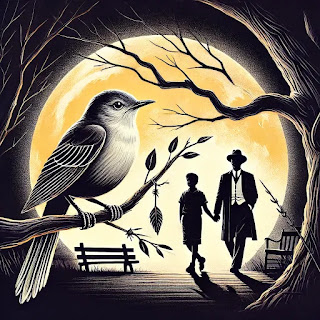To Kill a Mockingbird – A Detailed Review
Introduction
"To Kill a Mockingbird" is a famous American novel written by Harper Lee and first published in 1960. The story is set in the 1930s in a small town in the Southern state of Alabama and explores deep social issues such as racism, injustice, morality, and empathy.
The novel revolves around a court case in which a Black man is falsely accused of assaulting a white girl. Alongside this, it beautifully portrays the innocent perspectives of children as they grow and learn about the harsh realities of the world.
This book is considered one of the greatest works of American literature, and it continues to be relevant today as a powerful commentary on justice, compassion, and human dignity.
Summary of the Story
The novel is narrated by Scout Finch, a young girl who observes the world around her with curiosity and innocence. She lives with her older brother, Jem Finch, and their widowed father, Atticus Finch, who is a respected lawyer.
The main conflict arises when Atticus takes on the legal defense of Tom Robinson, a black man falsely accused of assaulting Mayella Ewell, a white woman. As the trial progresses, it becomes evident that Tom is innocent. However, due to the deep-rooted racism in their society, he is wrongfully convicted despite strong evidence in his favor.
The story also follows Scout and Jem as they grow up and learn important life lessons from their father, Atticus, who teaches them about justice, integrity, and empathy. Meanwhile, another subplot revolves around Boo Radley, a mysterious neighbor whom the children fear, only to later discover his kindness.
Major Themes
1. Racism and Injustice
The novel's central theme is the racial discrimination prevalent in the American South during the 1930s. Tom Robinson’s trial serves as a reflection of the racial bias in the legal system, where white supremacy dictates justice rather than facts or truth.
2. Morality and Empathy
Atticus Finch stands as the moral compass of the novel. He teaches his children:
"You never really understand a person until you consider things from his point of view."
This lesson about seeing the world from another person's perspective is repeated throughout the novel, urging readers to practice compassion and fairness.
3. Loss of Innocence
Scout and Jem start as innocent children but gradually learn about the cruelty and injustice in the world. Jem, in particular, is deeply affected by Tom Robinson’s unfair trial, realizing that the world is not always just or fair.
4. Fear and Stereotypes
The character of Boo Radley represents the dangers of prejudice and rumors. Initially feared by the children due to town gossip, he turns out to be a kind and protective figure, showing that appearances and assumptions can be misleading.
Character Analysis
Atticus Finch
Atticus is the heart of the novel. As a lawyer, father, and moral guide, he represents justice and integrity. Despite knowing that defending Tom Robinson will bring backlash, he still stands by the truth, proving that courage is standing for what is right, even when the odds are against you.
Scout Finch
Scout is a curious and intelligent girl who questions societal norms. Her journey from childhood innocence to understanding complex moral issues is one of the novel’s most compelling aspects.
Jem Finch
Jem, Scout’s older brother, undergoes significant emotional growth. His realization of the injustice in the legal system deeply affects him, making him one of the novel’s most emotionally engaging characters.
Tom Robinson
Tom represents the victim of racial prejudice. Despite being a kind and hardworking man, he is convicted simply because he is black, highlighting the systemic racism of the time.
Boo Radley
Initially portrayed as a mysterious and frightening figure, Boo is actually a gentle and misunderstood person. His character teaches an important lesson: we should not judge others based on rumors or stereotypes.
Literary Significance
"To Kill a Mockingbird" is widely regarded as one of the most influential novels of all time. It won the Pulitzer Prize in 1961 and continues to be studied in schools and universities worldwide.
1. Writing Style
Harper Lee’s storytelling is unique because she presents the novel through the eyes of a child, making complex social issues more accessible and emotionally impactful.
2. Social Impact
The novel remains relevant today, as it addresses racism, justice, and moral responsibility, issues that still resonate in modern society.
Memorable Quotes
✔ "People generally see what they look for, and hear what they listen for."
(This highlights how people often believe only what they want to believe, ignoring the truth.)
✔ "Real courage is when you know you're licked before you begin, but you begin anyway and see it through no matter what."
(Atticus teaches that true bravery is fighting for what’s right, even when the chances of winning are slim.)
Final Thoughts
"To Kill a Mockingbird" is more than just a novel—it is a lesson in justice, morality, and compassion. The book challenges readers to reflect on their own biases and ethical beliefs.
It is a must-read for anyone who wants to understand societal injustice and human nature. The novel’s timeless themes and unforgettable characters make it one of the greatest works of literature ever written.



Comments
Post a Comment